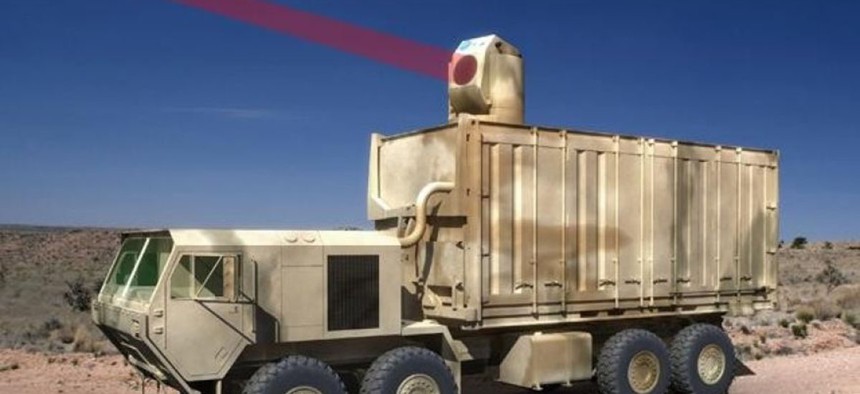US Army to Test Powerful New Truck-Mounted Laser ‘Within Months’

U.S. Army
New solid-state lasers plus ever-more-powerful mobile generators brings directed energy weapons a big step closer to reality.
Progress in battlefield lasers is exceeding some of the most optimistic expectations of just a few years ago. The latest evidence comes from Lockheed Martin, which Thursday announced a new record: 58 kilowatts of direct power from a solid-state fiber laser.
Lockheed will send it to the Army in a matter of months for testing on a High Energy Laser Mobile Test Truck, or HELMTT, according to Lockheed’s Robert Afzal, a senior fellow for laser and sensor systems. But Afzal says the scalability of the laser opens up use on everything from drones to massive ships and at different levels of power.
First, how powerful is a 58-kilowatt laser? Nearly twice as fierce as the company’s ATHENA, which can be seen burning through the hood of a car from miles away in this 2015 video.
The new laser puts 40 percent of available energy into its beam, which is considered very high for solid-state lasers.
The Defense Department put out the call for a 50-kilowatt laser in 2014, looking to upgrade the 10-kilowatt beam on its High-Energy Laser Mobile Demonstrator project, or HEL MD, launched in 2011.
The new laser will “upgrade the capability of that truck by a factor of five at least,” Afzal said today on a call with reporters.
It’s an important breakthrough for solid-state, combined-beam fiber lasers. Unlike the chemical lasers the military was experimenting with decades ago, solid-state lasers require no volatile chemicals to produce high-powered beams. A combined-beam fiber laser operates a bit like a prism, pulling together different beams of light and squishing them into one. The more fiber optics you add, the more energy you get out the other end. That allows you to vary the size for different applications.
But there is another reason you’ll see more lasers in combat soon. More and more military vehicles and trucks are using advanced hybrid engine and propulsion systems that produce electricity for applications like lasers. In the small-truck range, the Northrop Grumman Hell Hound produces 100 kilowatts of onboard power. Drone manufacturer Auroa Flight Sciences is also using a novel electricity-producing engine on it’s experimental vertical-lift drone, the LightningStrike. The company is looking to incorporate lasers on that platform as well.
Last October, Afzal said Lockheed was exploring putting fiber lasers onto the F-35 Joint Strike Fighter. The Air Force is looking to build lasers onto fighter jets through its recently announced Self-protected High-Energy Laser Demonstration, or SHIELD, program. U.S. Special Operations Command is also looking to deploy a laser on an AC-130J gunship within a year.
Afzal was optimistic the Lockheed Martin laser could help meet all of those needs:
“The core of this technology, and our demo validates this, this technology is scalable," he said. "We can go up or down in power, go smaller or larger.”






